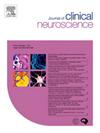Cervical extensor muscles involution in patients with symptomatic degenerative conditions: Comparative analysis and impact on alignment parameters
IF 1.9
4区 医学
Q3 CLINICAL NEUROLOGY
引用次数: 0
Abstract
Introduction
In recent years, researchers have studied the impact of lumbar paraspinal muscles’ fatty infiltration (FI) on instability and pain. FI is also commonly found in patients with cervical spine conditions such as degenerative myelopathy and spondylosis. Increased FI in the cervical flexor and extensor muscles has been linked to higher pain and disability. This study aims to analyze the composition of extensor muscles in preoperative imaging for patients undergoing cervical spine surgery, correlating them with cervical alignment and demographic parameters.
Materials and Methods
This retrospective study examined adults aged 18 and older who had surgery for cervical myelopathy due to spondylosis in the past five years. We recorded the type of surgery performed—either anterior cervical discectomy and fusion (ACDF) or posterior laminectomy—and categorized patients into two groups: anterior (AT) for disc spondylosis and posterior (PT) for degeneration of facet joints. We evaluated preoperative T2-weighted MRI scans for fat infiltration (FI) and cervical spine X-rays for alignment. Specifically, we assessed the FI to muscle tissue (MA) ratio in the paraspinal extensor muscles from C2 to C7. Univariate and multivariate logistic regression models were used to compare cervical alignment, %FI, and demographic factors.
Results
We identified 143 patients; 78 were included in the AT and 65 in the PT group. A significantly higher %FI was found in PT patients than in AT (1.8 % ± 2.6 % vs. 5.0 % ± 7.6 %, p-value: 0.015, respectively). Multivariate analysis showed a correlation with lower odds of spondylosis for lower values of T1S (OR 0.94, 95 % CI 0.89–0.98, p-value: 0.017) as well as lower odds of spondylosis for lower values of FI (OR 0.83, 95 % CI 0.71–0.98, p-value: 0.029).
Conclusions
We found that patients with single or multilevel stenosis had a much higher degree of %FI in the extensor muscles. Additionally, we observed significant differences in cervical lordosis and T1S values between the two groups, with patients with anterior compression showing significantly lower values of CL and T1S.
求助全文
约1分钟内获得全文
求助全文
来源期刊

Journal of Clinical Neuroscience
医学-临床神经学
CiteScore
4.50
自引率
0.00%
发文量
402
审稿时长
40 days
期刊介绍:
This International journal, Journal of Clinical Neuroscience, publishes articles on clinical neurosurgery and neurology and the related neurosciences such as neuro-pathology, neuro-radiology, neuro-ophthalmology and neuro-physiology.
The journal has a broad International perspective, and emphasises the advances occurring in Asia, the Pacific Rim region, Europe and North America. The Journal acts as a focus for publication of major clinical and laboratory research, as well as publishing solicited manuscripts on specific subjects from experts, case reports and other information of interest to clinicians working in the clinical neurosciences.
 求助内容:
求助内容: 应助结果提醒方式:
应助结果提醒方式:


